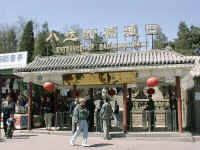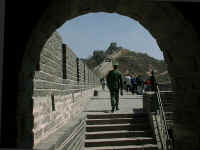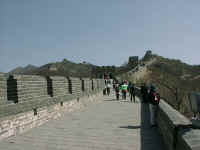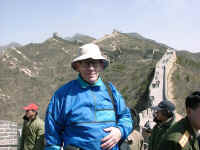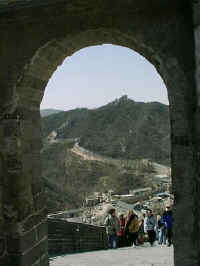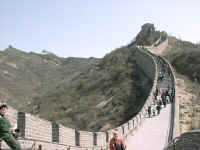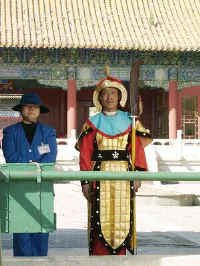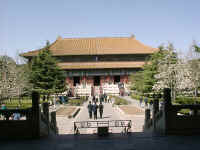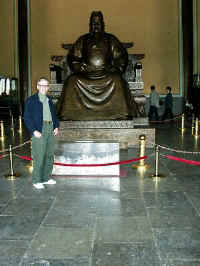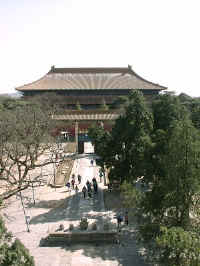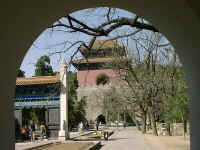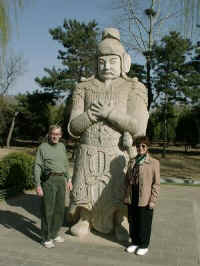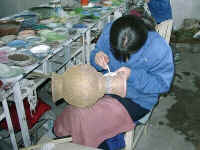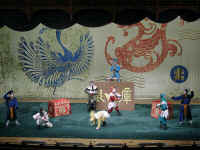|
THE GREAT WALL The Badaling entrance is near the low spot of a very steep dip as the Wall crosses a valley. Whichever direction you go, eventually there is a steep climb. The difference is that the "easy" side starts out as a fairly level stretch. It soon gets very steep, however, and if you go far enough, it's actually higher than the "difficult" side. We probably went further than we should have. Jane was still very weak and found the climb very difficult. The cold wind didn't help. Nevertheless, it was a thrill to find ourselves on top of the Great Wall. Construction of the Wall started in the 7th century B.C. After the unification of China in 221 B.C., the various sections were joined to form a single wall more than 3,000 miles long. In 1368 the Ming Dynasty began a major renovation that continued for two centuries. In addition, many new sections were added, bringing the total length of the Wall to more than 3,800 miles. The Badaling section that we saw was one of the 14th century additions (now largely restored). It averages more than 25 feet in height and 19 feet in width at the top. Every so often there are towers with battle ports.
By the time we came down from the Wall, the weather had improved noticeably. The area at the base of the Wall, and extending for the entire two blocks to the bus parking lot, was lined with little stands selling tourist souvenirs. Every vender, on spotting any "big nose" (Caucasian) passing by, would waive some piece of merchandise and shout out an endless, rapid fire string of hellos to get attention. Since several venders could see us at once, and often on both sides of the street, there was a constant cacophony of "hello, hello, hello, hello, . . . ." MING TOMBS We left Badaling around 1:00 p.m., and the bus took us south toward the Ming Tombs. We stopped for lunch along the way. Between 1409 and 1644, thirteen Ming emperors were buried in separate tombs in a 16 square mile area. Each tomb is located at the foot of a separate hill and is linked with the other tombs by a road called the Sacred Way. We visited only the Chang Ling Tomb (built in 1413), where Emperor Yong Le was buried. There were several ornate buildings and beautiful gardens. It was more like a palace than a tomb and, truth be told, more enjoyable than the Forbidden City. Afterwards we walked the length of that section of the Sacred Way open to tourists. It must have been close to a mile long and was lined on both sides with matching pairs of huge statues of various officials and animals, 18 pairs in all. By the time we met the bus at the far end, the day had become sunny and quite warm.
Our next stop was a cloisonne' factory. On a business trip to Korea years
before, I had bought a beautiful, large Chinese
cloisonne' bowl, as well as an elaborate box for playing cards. It was fascinating to see how it was
made, so labor intensive. Putting a complex design with copper wire on a copper body was hard
enough, but then an eye dropper was used to fill in each little section with the appropriate color
of porcelain.
BEIJING Coming back into Beijing, we were running very late, so the bus took us directly to the restaurant without stopping at the hotel. Even so, we didn't get to the restaurant until 6:40, and the Beijing Opera was scheduled to start at 7:30 a few blocks away. It was quite a rush, but somehow we managed to get seated just as the curtain went up. (This was the only glitch in an otherwise perfectly managed tour.)
The Opera was quite a surprise. As became clearer later when we saw other operas in
Xian and Tibet, the word "opera" in China refers to most any entertainment by costumed
performers. While there were two songs performed by a singer offstage (the most awful
screeching you can imagine), the longest and best done part of the Beijing Opera was performed
by acrobats and jugglers ("Stealing Silver"). There was also one short "dramatic" skit
("Blocking Horse") with an almost sophomoric plot. In the finale of "Stealing Silver" the
heroine/star continuously hit and kicked eight lances directly back into the hands of four
attackers who threw them at her. At one point she deflected four lances at once, hitting two with
her arms and kicking with both feet at the same time without falling down. It was very
impressive. The opera ended at 9:00 p.m., and we were glad to get back to the hotel. We had
been on the go for 13 hours.
Copyright © 2000-2023 DarrellPeck.com All rights
reserved. | |||||

